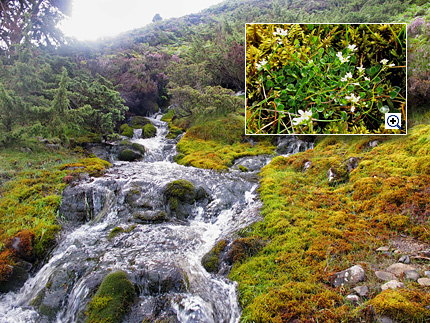The evolutionary history of Cochlearia (Brassicaceae) in Central Europe: Population genetics and phylogenomics of a cold relic in a warming world
Project code: KO 2302/16-1

Cochlearia population in Scotland – spring habitat with cold streaming water at high elevation.
The genus Cochlearia represents an isolated evolutionary lineage that diverged from its Mediterranean sister clade during the Miocene and since that did not underwent any significant speciation until Pleistocene glaciation and deglaciation cycles. During the Pleistocene approximately 20 taxa evolved, with most of the species closely associated with cold-characterized habitats. Similar eco- and phenotypes of varying ploidy levels emerged and are scarcely distributed all over Europe and the Circumarctic. One sub-group of species is occurring mostly along coastal lines and a second sub-group is highly restricted to mountain and high elevation/altitude regions. The proposed project aims to unravel the evolutionary history of the various species, subspecies and cytotypes on a high-resolution-scale in space and time. The resulting evolutionary-systematic framework will lay the ground to study in particular hypotheses on parallel evolution and adaptation to cold environments with its respective characteristics and types of habitats (e.g. bedrock types, elevation, etc.). The Cochlearia study system provides the great opportunity to study closely linked traits and characters, because of various naturally occurring species pairs which are obviously, at least geographically, separated from each other. This will allow to study and test explicitly parallel evolution and adaptation.
The data used herein are mostly based on next-generation-sequencing data utilizing information from all three plant genomes (nuclear, plastid, mitochondrial). These data will not only allow high-resolution analysis, but will also provide first access to thousands of genes and loci.
The genus Cochlearia should be also developed towards a system to study in future molecular(genomic)-evolutionary signatures of cold adaptation. For this purposes the western Mediterranean sistergroup Ionopsidium is conceptually integrated to expand and stimulate future research accordingly.
Publications related to the project
- Huang CH, Sun R, Zeng YH, Zhang N, Cai L, Zhang Q, Koch MA, Al-Shehbaz IA, Edger PP, Pires JC, Tan DY, Zhong Y, Ma H (2015) Resolution of Brassicaceae phylogeny using nuclear genes uncovers nested radiations and supports convergent morphological evolution. Molecular Biology and Evolution. [Epub ahead of print]


- Hohmann N, Wolf EM, Lysak MA, Koch MA (2015) A
Time-Calibrated Road Map of Brassicaceae Species Radiation and
Evolutionary History. The Plant Cell. 2015 Sep 26. pii: tpc.15.00482.


- Koch MA (2012) Mid-Miocene divergence of Ionopsidium and Cochlearia and its impact on the systematics and biogeography of the tribe Cochlearieae (Brassicaceae). TAXON 61: 76-92. (Full text)
- Al-Shehbaz I, Koch M A (2010) Cochlearia. In: Flora of North America, vol. 7, Oxford University Press. pp. 514-516.
- Koch M, Mummenhoff K, Hurka H (1999): Molecular phylogenetics of Cochlearia (Brassicaceae) and allied genera based on nuclear ribosomal ITS DNA sequence analysis contradict traditional concepts of their evolutionary relationship . Plant Syst. Evol. 216: 207-230. (Full text)
- Koch M, Huthmann M, Hurka H (1998): Isozymes, speciation and evolution in the polyploid complex Cochlearia L. (Brassicaceae). Botanica Acta 111: 451-466. (Full text)




